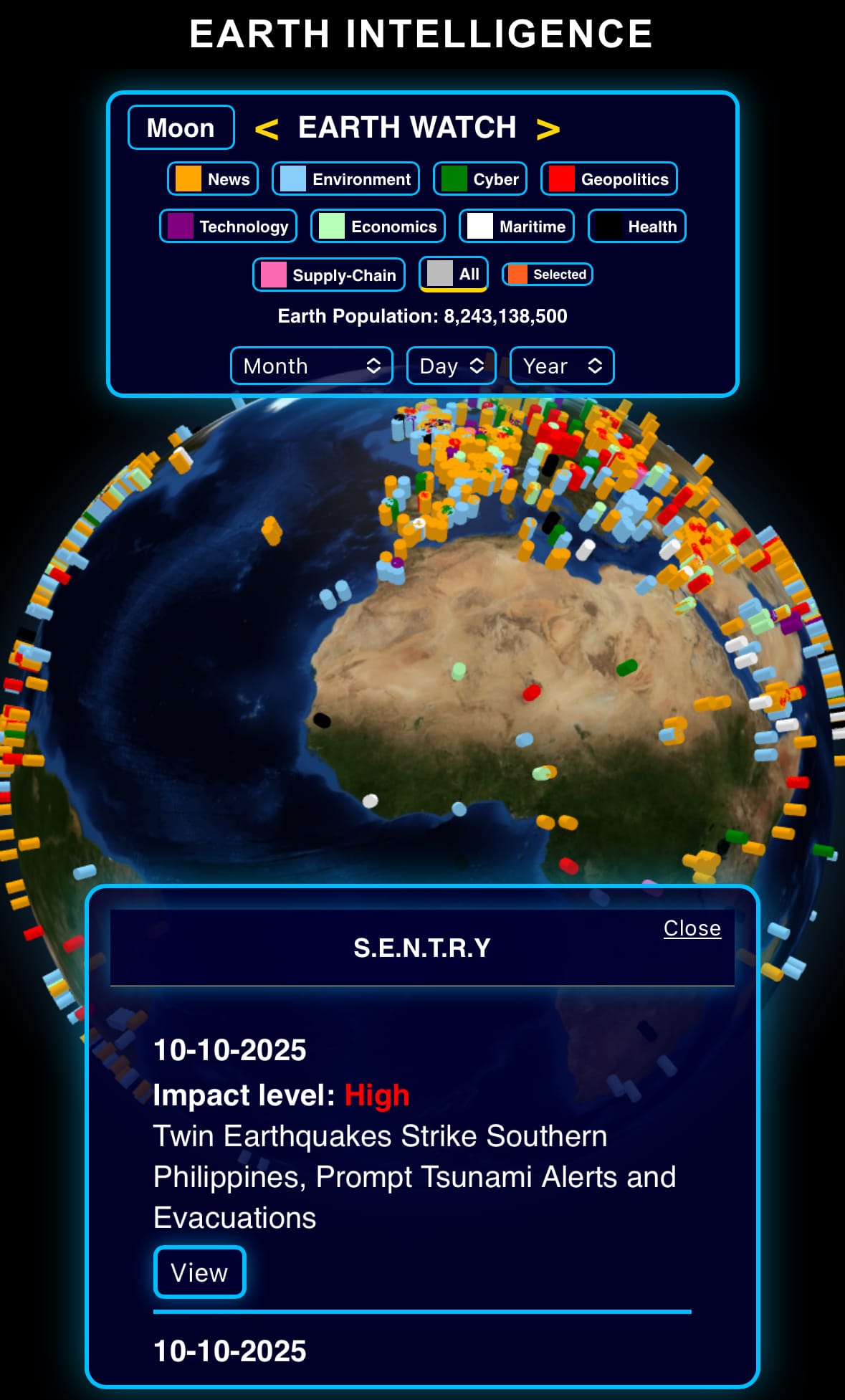Tuesday☕️

Economics & Markets:
- Yesterday, October 13, 2025, JPMorgan Chase introduced its Security and Resiliency Initiative, a $1.5 trillion plan over 10 years to support, finance, and invest in U.S. industries important for economic and national security. The program features up to $10 billion in direct investments and venture capital for companies in four main categories: defense and aerospace, emerging technologies like quantum computing, supply chains and advanced manufacturing, and energy independence including critical minerals and pharmaceuticals. CEO Jamie Dimon noted the bank's commitment to projects that build U.S. strength, based on its current work in areas such as defense and infrastructure.
- The initiative arises during increased U.S.-China trade issues and worries about supply chain weaknesses, placing JPMorgan as a supporter in building stronger home-based abilities in key areas. It shows a pattern among financial groups matching government goals for security, which might include providing loans, funding projects, and advice to encourage new ideas and lessen dependence on overseas supplies.
- Yesterday’s U.S. stock market:

- Yesterday’s commodity market:

- Yesterday’s crypto market:

Geopolitics & Military Activity:

Environment & Weather:

Space:
- On October 13, 2025, SpaceX successfully conducted the 11th test flight of its Starship vehicle from the Starbase facility in South Texas, marking another step in the development of the fully reusable spacecraft system. The launch occurred within a window opening at 6:15 p.m. CT, with the Super Heavy booster performing a splashdown in the Gulf of Mexico after separation, while the upper stage Starship prototype continued its trajectory for suborbital testing. No major anomalies were reported during the ascent, and the test focused on evaluating propulsion, staging, and reentry dynamics, building on data from prior flights. Coordination with the FAA ensured minimal disruption to airspace, with affected areas reopened within minutes post-launch.

- This flight represents the culmination of the Block 2 upper stage series for Starship, ahead of planned upgrades to prototypes, and aligns with SpaceX's broader goals for rapid iteration toward crewed missions to the Moon and Mars under NASA's Artemis program. The test also highlighted preparations for deploying advanced V3 Starlink satellites, which promise significantly higher bandwidth capacity.
Science & Technology:
- On October 13, 2025, Anduril Industries introduced EagleEye, a set of augmented reality helmet systems meant to add mission control and AI features to helmets used by military personnel. The setup shows digital data over the user's actual view using a heads-up display, offering immediate details like tracking team members' positions in 3D and spotting threats not in direct view. It also allows connections to operate drones, request strikes, and handle robots, while working in areas with poor communication through a network that links devices together. The design includes protection against bullets, sensors on the back and sides, sound that indicates direction, and detection of radio signals to improve safety and awareness.
- Demonstration video:

- Created with input from firms such as Meta, Oakley, Qualcomm, and Gentex, EagleEye seeks to give troops better senses, links to tools, and chances to survive without much extra weight or difficulty. Anduril intends to provide about 100 units to the U.S. Army in 2026 for testing. This launch marks progress in tech worn by soldiers, drawing from virtual reality ideas to aid choices in fights, while sparking talks about using AI in battles and related moral questions.

Statistic:
- Largest public mining companies on Earth by market capitalization:
- 🇦🇺 BHP Group: $146.14B
- 🇨🇳 Zijin Mining: $115.01B
- 🇬🇧 Rio Tinto: $114.49B
- 🇨🇳 China Shenhua Energy: $109.47B
- 🇺🇸 Southern Copper: $108.18B
- 🇺🇸 Newmont: $98.20B
- 🇨🇦 Agnico Eagle Mines: $86.45B
- 🇸🇦 Ma’aden: $68.86B
- 🇲🇽 Grupo México: $63.31B
- 🇺🇸 Freeport-McMoRan: $61.42B
- 🇨🇭 Glencore: $58.00B
- 🇨🇦 Barrick Gold: $57.01B
- 🇨🇳 CMOC: $49.51B
- 🇨🇦 Wheaton Precious Metals: $49.47B
- 🇧🇷 Vale: $48.41B
- 🇬🇧 Anglo American: $43.97B
- 🇨🇦 Franco-Nevada: $40.77B
- 🇨🇦 Cameco: $40.12B
- 🇿🇦 Gold Fields: $39.51B
- 🇦🇺 Fortescue: $39.23B
- 🇿🇦 AngloGold Ashanti: $37.63B
- 🇷🇺 Polyus: $37.39B
- 🇬🇧 Antofagasta: $37.16B
- 🇮🇩 Bayan Resources: $36.55B
- 🇨🇦 Kinross Gold: $31.09B
History:
- The military’s use of eye-focused wearables dates back to the early 20th century, beginning with World War I aviators who wore leather helmets paired with basic goggles to protect against wind, debris, and oil spray in open cockpits. During World War II, advancements in aviation led to improved goggles and visors that provided UV protection and anti-glare features, especially for bomber and fighter pilots. In the 1950s and 60s, jet pilots began using helmet-mounted visors with polarized lenses and integrated oxygen masks, while heads-up displays (HUDs) emerged in fighter aircraft by the 1970s, allowing pilots to see targeting and navigational data without looking down. On the ground, the Vietnam War era saw the initial use of night vision devices, and by the 1990s, night vision goggles (NVGs) became standard for infantry operations, enabling forces to operate effectively in darkness. Throughout the early 2000s, the focus shifted to combining vision systems with sensors, communications, and target acquisition—laying the groundwork for augmented reality (AR) integration in tactical headsets.
- By the 2010s, programs like the U.S. Army’s Integrated Visual Augmentation System (IVAS) aimed to unify situational awareness tools—combining AR overlays, thermal imaging, GPS, and biometric data into a single heads-up display. Originally developed using Microsoft’s HoloLens platform, IVAS sought to give soldiers a real-time, heads-up view of the battlefield, much like what pilots had inside aircraft. In 2025, Anduril Industries took over primary responsibility for IVAS development, focusing on improvements to optics, comfort, and performance under combat conditions. In October 2025, Anduril launched EagleEye, a fully integrated, modular combat headset designed as part of the next-generation IBAS (Integrated Battle Augmentation System) effort. The system aims to move beyond goggles and displays, offering soldiers a unified platform for vision, communication, and data integration—marking a major evolution from early protective eyewear to today’s AI-enhanced warfighting helmets.
Image of the day:

Thanks for reading!
- The most challenging task in AI integration is organizing & optimizing legacy data systems to interact with modern cloud API’s (data pipelines) and AI’s. Once you get past the data organization process (hardest part), you can build any app since AI can write all the code now (Our team uses GPT-5 the most). We provide custom builds and integrations (works-for-hire that you own), while keeping our core newsletters and intelligence products free.
Earth is complicated, we make it simple.
- Click below if you’d like to view our free EARTH WATCH globe:


Click below to view our previous newsletters:

Support/Suggestions Email:
earthintelligence@earthintel.news




